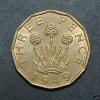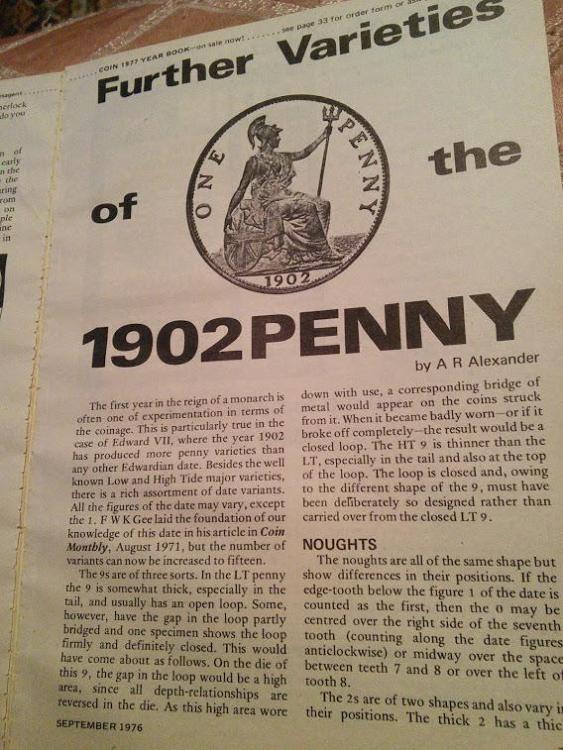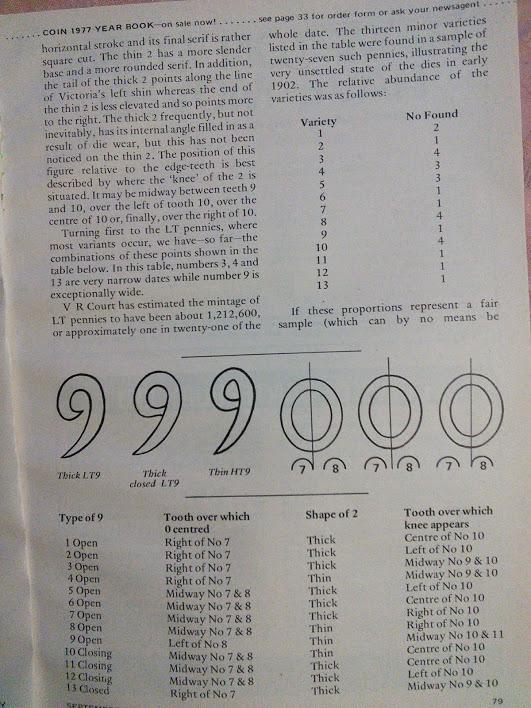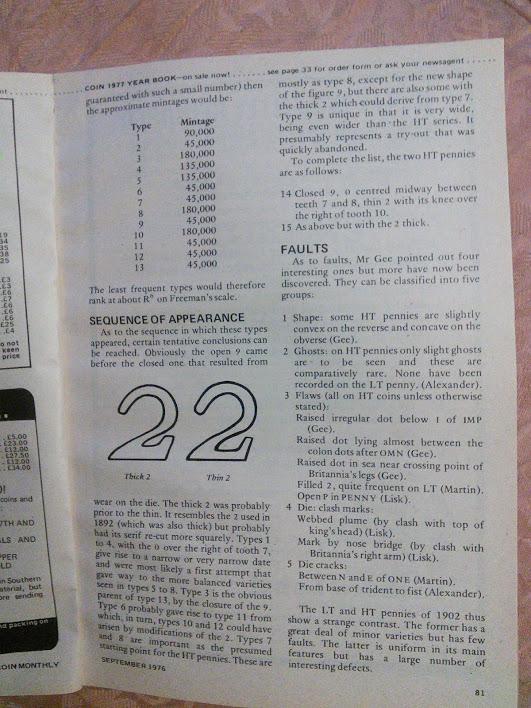-
Posts
8,081 -
Joined
-
Last visited
-
Days Won
262
Content Type
Profiles
Forums
Events
Downloads
Store
Gallery
Articles
Everything posted by 1949threepence
-
A very impressive collection. I'm not sure I agree with a few of his estimates on numbers currently extant, however. Moreover he's another one who adds "A's" onto Freeman numbers, for varieties not classified by Freeman at the time of his writing.
-
Exercise in semantics here. Having read Bramah's book recently, he uses the term "minor varieties" to describe every slight variance that is not otherwise (subjectively) "worthy" of categorisation. Maybe "micro" was not a word used in that numismatic context back then. Personally, I'd be inclined to use the term minor variety in the same context Bramah did, and reserve the term "micro variety" for variances which are not readily visible to the naked eye. Although that might encompass a few classed as significant........
-

Cleaned or not?
1949threepence replied to mrbadexample's topic in British Coin Related Discussions & Enquiries
Some do look a bit shiny and they haven't been cleaned or polished. -

Pedantry Corner...
1949threepence replied to Michael-Roo's topic in Nothing whatsoever to do with coins area!
But of course people do notice imperfections and they're a distraction. They're also a gift for media critics. So I'm not sure what you received was a reasonable answer. More one of being fobbed off. Indeed, if you weren't interested in the picture, you wouldn't be paying attention and would likely miss a detail like that anyway. I'm surprised a self admitted pedant like you would agree it was a reasonable reply. -
If you're querying how anyone would determine that it's a F103, as opposed to a Freeman 108?? there's a very easy way, which avoids studying worn incuse lines. Gouby Obverse P, which you'd normally observe as the natural obverse for an 1881H, shows the Queen with a hooked nose. Gouby Obverse M shows a straight nose. Both Gouby and Freeman mention the different nose shapes, which is fairly obvious, even on a worn coin.
-

Pedantry Corner...
1949threepence replied to Michael-Roo's topic in Nothing whatsoever to do with coins area!
Pedantry? actually that's the kind of error which seriously irritates me in period dramas. It's on a par with one I saw set in the 1890's, where you got a quick glimpse of a satellite dish on the side of someone's house. Forgotten what it was called. Or the continuity errors where an actor is talking to someone, and after the reply when the camera moves back to him, he's wearing a different tie. Then (being interested in trains), I saw one film from the 1950's which showed a train about to leave, and after the camera panned back to the locomotive after a romantic goodbye, same class of loco, but with a different number. Oh and not forgetting the film apparently set in December, where you can see fake snow falling outside the window. Then when they shoot outside, all the trees are in full leaf, and the shadows cast by the actors, very short - and it's not "6 months later". Oh and when they come in from the snow, the flakes just stay intact on their coats, instead of rapidly melting which they would in real life. ...and don't get me started on fake lightning, always cast as directly overhead, so the thunder is immediate.... OK call me a sad but observant pedant if you like. -
Wow, wish I'd seen it. I'd have been in for the kill on that one. As Richard says, price is spot on. They're even rarer than the 1877 narrow date, but usually go for a lot less. The seller obviously didn't have a clue what it was. Just hope the buyer contacts him for next day tracked delivery, and doesn't rely on 87p economy delivery
-

Cleaned or not?
1949threepence replied to mrbadexample's topic in British Coin Related Discussions & Enquiries
That doesn't looked cleaned. -
Richard, is that a new book for the entire period 1860 to 1970?
-

Cleaned or not?
1949threepence replied to mrbadexample's topic in British Coin Related Discussions & Enquiries
I'd say it's more probable than not that they haven't been cleaned. But can't be certain either way. If they have then the phrase, "sometime cleaned, now re-toning", comes to mind. -
Never seen that variant before, Ian. Thanks for the pic.
-
Yes yes. I've photographed all three pages as best I can, but copying pages is not the easiest task in the world. So apologies for their lack of perfection. They are readable though. Can't see much about a wavy 2, but the article is very interesting and useful.
-
I know Chris. I was being a bit tongue in cheek. But yes, you're right, it is a very good example. Quite convincing.
-

Penny Acquisition of the week
1949threepence replied to Paulus's topic in British Coin Related Discussions & Enquiries
I must be honest and say that although I now have most of the pre 1860 types, with the exception of the obviously really rare dates, I don't think any of them have truly merited an entry as penny acquisition of the week. But I'm making an exception for this one. It's an 1853 plain trident (very much the scarcer of the two types for 1853), and is in excellent overall condition, with no visible wear to the right breast area, which is the one of the first to see wear on these pennies. It complements the intermediate colon 1853 I got a few weeks ago, which is also quite scarce. I bought it from KB Coins, and surprisingly Keith Bayford only wanted £125 for it, as he normally charges top dollar for his stock. So I immediately went for it. I think £125 is a very reasonable price for this coin. -
The obverse is very real looking.
-
I'm wondering if this is actually some sort of optical illusion arising from other features of the 2 - when I hold something over the rest of the 2 on the one's touted as possible wavy line examples above, the base of the 2 appears dead straight.
-
....and quite apart from that, it's actually a very nice coin with a lot of eye appeal.....
-
Both mine are straight.
-
Has to be as it's certainly not "ruler straight".
-
There wasn't one, Terry. Just the reader letter.
-
Does this show up? I dropped in a copy of the previous effort as it was too big to import, and whilst it shows up on my personal devices, it doesn't on anyone else's. Nor on my work surface pro. Had this issue before. No idea what it's all about, but I've now compressed the snip to well below 500 kb and just imported it in the usual way this time. You should now be able to see, hopefully,.
-
Interesting reader letter from a Nigel Palk in the August 2020 edition of "Coin News", in which he refers to two varieties of 1902 LT penny. Here's a screenshot:-
-
........which is the wording underneath Churchill's portrait on the £5 note. Out of context it sounds so depressing and defeatist. I would much have preferred "we shall never surrender". In or out of context that sounds much more in line with the stubborn, defiant, never say die British Bulldog spirit. Others will undoubtedly disagree, but I just thought I'd share that random thought on here, before it disappeared into the ether, until the next time I was reminded of it.
-
Indeed. I just wondered if Bramah had copied bits directly out of Christmas's book, without modifying them such that they would fit in with the time he was writing. Probably didn't but it fleetingly crossed my mind.
-
So not quite a 2:1 ratio in favour of the PT. Thanks very much Ian. Once again, incredibly useful info. It's odd, isn't it, that Peck made no reference to date width, size, and digit design (for want of a better phrase), except for 1857 to 1859 "small dates". Especially given that date differences prior to 1857, especially 1853 and 1856, are very obvious to the naked eye, and far from subtle. Bramah mentions 1857 (specifically) having a much smaller date variety, presumably because of a report in the Spink Numismatic Circular of March 1895. Apart from that he seems somewhat dismissive of date differences in terms of collectable varieties, because of the sheer number - "innumerable", as he points out. Yes, Bramah mentions Henry Christmas's work "Copper and billon coinage of the British Empire" (1864) in his bibliography. Something he says at page 108 seemed slightly odd in view of the fact that by 1929, 60 odd years had passed since demonetisation of pre 1860 copper. Yet he says: "......it is very doubtful if any casually-acquired hundred specimens would in practice contain any examples of those dates to which 1 per cent is allocated. The simple reason is that the scarce dates are retained by collectors and will not be found in promiscuous assemblages". Where would anybody have "casually acquired" 100 specimens in 1929? Certainly not from change. By definition they would only be available for sale as collectors items, or the odd few in jam jars etc. Of course, I'm pre-supposing that huge bagfuls of random copper coins weren't available then, in the same way as they are now for pre decimal bronze.






